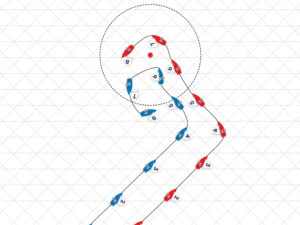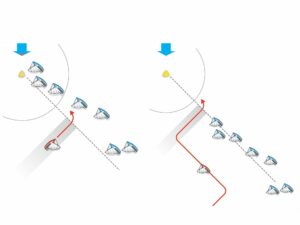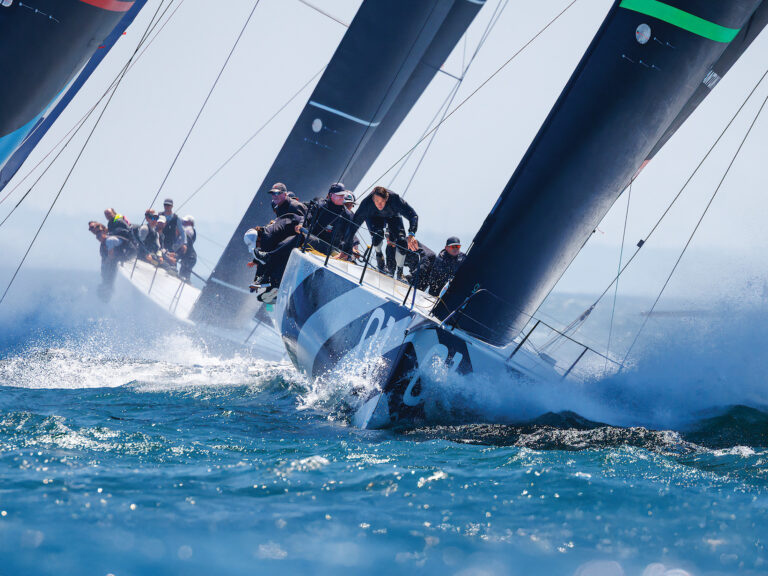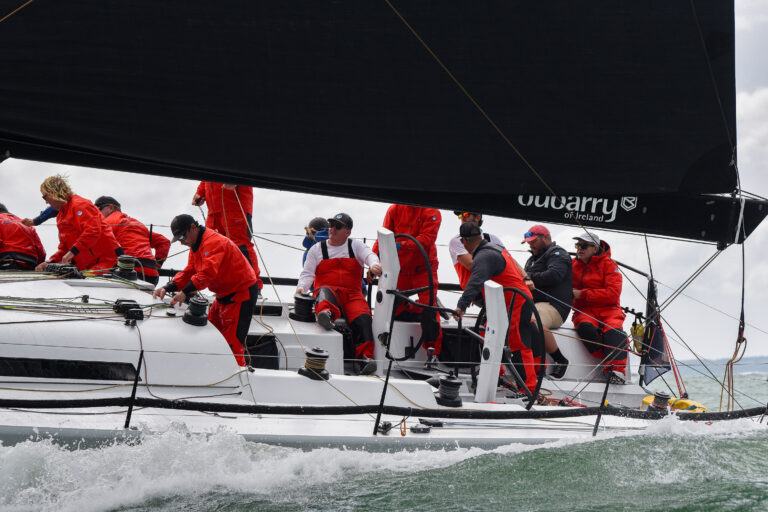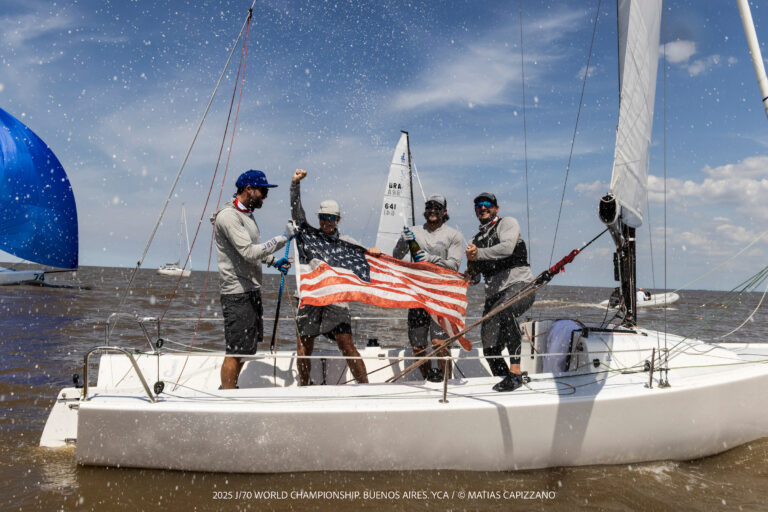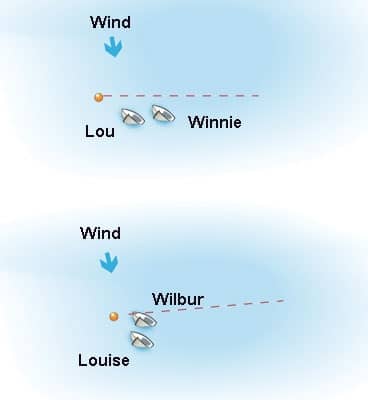
FTERose368B
The majority of questions I receive are about incidents near a mark, and most of those involve the rules of Section C, At Marks and Obstructions. However, there are many situations where the applicable rules are not the rules of Section C, including the following situation described in an e-mail from a reader I only know as Bill. He asked how the rules apply to a common starting situation that he described as follows: “Right after the starting signal a leeward boat pinches to make the start pin and then luffs in an effort to clear it. In doing so a windward boat is forced to luff up to keep clear. Unfortunately the boats begin to stall. The boats bump and the leeward boat hits the start pin. The leeward boat says the windward boat didn’t keep clear and the windward boat feels it did all it could.”Bill does not provide us with enough facts to give a single comprehensive answer as to which boat was “right” and which “wrong.” The result of a protest would depend heavily on additional facts and on difficult judgments made by the judges. I’ll discuss the applicable rules and various factors that would influence the protest committee’s decision and, finally, I’ll offer a bit of advice. In particular, Bill doesn’t state the fore and aft positions of the boats relative to each other. That can be important. I’ll discuss the two examples shown in the diagrams above. In the first, Lou is bow out on Winnie, and in the second, Wilbur is bow out on Louise.To begin, let’s eliminate rules that do not apply. Obviously, the boats are approaching the starting line to start. The mark is surrounded by navigable water. Rule 18.1(a) tells us that Rule 18 does not apply in such a circumstance. That eliminates the most complicated rule and it means that we need not even consider the two-length zone or ask whether the boats were overlapped or not when the first of them reached the zone. I show the mark as an object too small to rank as an obstruction. However, even if it were an obstruction, Rule 19.1 would not give the leeward boat the right to hail for and obtain room to tack because Rule 19.2 states that Rule 19.1 does not apply on the approach to an obstruction that is a starting mark surrounded by navigable water.You might ask whether Rule 17.1 applies. It would only apply if the boats became overlapped because the leeward boat had been clear astern and then became overlapped while within two hull lengths of the other boat. Even if she did, Rule 17.1 never applies before the starting signal as there is no proper course at that time. After the signal, the leeward boat always has the right to sail as high as her proper course. In this case, the leeward boat’s proper course is to luff to pass to windward of the mark without touching it. This means that, even if Rule 17.1 applied, the luff described by Bill would never be so high as to break it. Obviously, we can also easily eliminate Rules 10, 12, 13, 16.2, 17.2, 20, 21 and 22.That leaves us with just three Part 2 rules-Rule 11, requiring the windward boat to keep clear, Rule 14, requiring both boats to avoid contact if reasonably possible, and Rule 16.1, which implies that when the leeward boat changes course she must give the windward boat room to keep clear. The definitions Keep Clear and Room are critical. They are both given in the nearby box.What often makes this situation difficult to analyze is the fact that as the leeward boat changes course by luffing each boat can cite a rule that’s in her favor. Rule 11 favors the leeward boat by requiring the windward boat to keep clear, and Rule 16.1 favors the windward boat by requiring the leeward boat to luff so as give the windward boat room to keep clear.If the boats are positioned as Lou and Winnie are in the first diagram, then Lou is more likely to prevail in the protest room, whereas if the windward boat is bow out, as Wilbur is in the second diagram, he is more likely to prevail. The reason for this is that, as the boats luff they pivot about their centerboards or keels. Therefore, if Lou and Winnie luff at the same rate, the distance between them should not change. However, as Louise luffs Wilbur, the distance between the starboard side of Louise’s bow and the port side of Wilbur’s stern will inevitably narrow until, at some point, the boats cannot luff further without making contact. If Louise were to luff beyond that point, she would clearly break Rule 16.1. The type of boat also would be important. If Louise and Wilbur were sailing classic old keel boats with long overhangs, then Wilbur would be unable to respond to Louise’s luff sooner than would be the case if the boats did not have long overhangs.If neither boat is bow out on the other, then it much becomes more difficult to predict which boat will prevail.Here are several facts that, if found, would strengthen the leeward boat’s case: (1) If, before the leeward boat luffed, the lateral separation between the boats was so slim that the leeward boat could not begin to luff without immediately making contact with the windward boat. (2) If the windward boat did not act promptly and vigorously to keep clear as the leeward boat luffed. (3) If the leeward boat luffed slowly and hailed clearly before doing so.Here are several facts that, if found, would strengthen the windward boat’s case: (1) If the windward boat was careful at all times to do all she could to maintain enough separation between the boats so that the leeward boat could always make at least a small luff without immediately making contact with the windward boat. (2) If the leeward boat luffed rapidly or without hailing. (3) If the leeward boat luffed so high that the only way for the windward boat to keep clear was to turn to past head to wind and if so doing would have cause her to break Rule 13 by tacking in front of other boats behind and to windward. (4) If, despite luffing promptly and vigorously in response to the leeward boat’s luff, the windward boat was unable to avoid contact.What about Rule 14? The leeward boat could easily avoid contact by simply bearing off when she saw that contact was about to occur. It might be more difficult for the windward boat to avoid contact. However, Bill reported that the boats just “bumped” and so it is unlikely that there was any damage, in which case neither boat could be penalized because the leeward boat was a right-of-way boat and the windward boat was entitled to room as the leeward boat luffed (see Rule 14(b)).What if the leeward boat touched the mark? If the protest committee found that the windward boat broke Rule 11 and, consequently, the leeward boat was compelled to touch the mark, then the leeward boat would not be penalized for breaking Rule 31.1 (see Rule 64.1(b)).Here is a bit of advice for the leeward boat. If the windward boat is bow out as Wilbur is in the second diagram, then jibing around and taking some sterns may be far preferable to attempting a luff. If you do decide to luff, try to have speed on before luffing as that will help to minimize leeway and enable you to clear the mark with a smaller change in course. Warn the windward boat by hailing repeatedly before luffing that you have the right to luff to clear the mark.
E-mail for Dick Rose may be sent to rules@sailingworld.com

